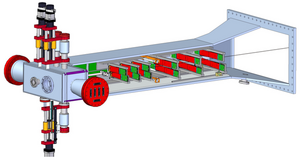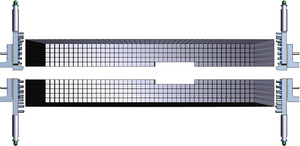Difference between revisions of "The HPS Run Wiki"
Jump to navigation
Jump to search
| Line 105: | Line 105: | ||
# Follow the instructions under "Procedures" on the documentation tab for "Beamline"[https://wiki.jlab.org/hps-run/images/e/e6/HPS_beamline_comm.pdf] to establish beam to the electron dump. <b> Note: in order to have reliable readings on two important for HPS BPMs, 2H00 and 2H02, beam current should be >25 nA</b>. All studies should be done with beam currents between 25 nA and 30 nA. | # Follow the instructions under "Procedures" on the documentation tab for "Beamline"[https://wiki.jlab.org/hps-run/images/e/e6/HPS_beamline_comm.pdf] to establish beam to the electron dump. <b> Note: in order to have reliable readings on two important for HPS BPMs, 2H00 and 2H02, beam current should be >25 nA</b>. All studies should be done with beam currents between 25 nA and 30 nA. | ||
#* <b> Before moving forward with 2H02A harp scans and beam profile tune, stripline BPMs 2H00 and 2H02 must be calibrated and orbit lock must be operational.</b> At the moment 2H00 does not work and calibration of both is in question. Expert has been called in. If issue will not be resolved, still some parts of the program below can be executed if beam is not moving round much (can be manually controlled for slow drifts).+ | #* <b> Before moving forward with 2H02A harp scans and beam profile tune, stripline BPMs 2H00 and 2H02 must be calibrated and orbit lock must be operational.</b> At the moment 2H00 does not work and calibration of both is in question. Expert has been called in. If issue will not be resolved, still some parts of the program below can be executed if beam is not moving round much (can be manually controlled for slow drifts).+ | ||
| − | # The required beam profile at 2H02A harp is: X-width <~0.25 mm, Y-width <~ 0.05 mm, and the tilt angle <15 degrees. Michael T. will come to work on improving Hall-B beam profile. If after few hours (before midnight) settle on some reasonable configuration. If beam profile is not exactly as required, but beam positions on 2H02 BPM are stable within 0.2 mm in X and 0.1mm in Y, the following still can be done: | + | # The required beam profile at 2H02A harp is: X-width <~0.25 mm, Y-width <~ 0.05 mm, and the tilt angle <15 degrees. Michael T. will come to work on improving Hall-B beam profile. If after few hours (before midnight) settle on some reasonable configuration when HPS-l/R are few 100 Hz. If beam profile is not exactly as required, but beam positions on 2H02 BPM are stable within 0.2 mm in X and 0.1mm in Y, the following still can be done: |
<!-- #* Verify positions and sizes of SVT protection collimator holes as assigned on the GUI. Move collimator with steps of 0.1 mm and record rates on HPS-L/R/T/SC halo counters. Find the optimal position based on rates. | <!-- #* Verify positions and sizes of SVT protection collimator holes as assigned on the GUI. Move collimator with steps of 0.1 mm and record rates on HPS-L/R/T/SC halo counters. Find the optimal position based on rates. | ||
#* Center beam on HPS using ECal rates (see instructions under "Procedures" on the documentation tab for "Beamline"[https://wiki.jlab.org/hps-run/images/e/e6/HPS_beamline_comm.pdf]). --> | #* Center beam on HPS using ECal rates (see instructions under "Procedures" on the documentation tab for "Beamline"[https://wiki.jlab.org/hps-run/images/e/e6/HPS_beamline_comm.pdf]). --> | ||
| + | #* Turn ON Ecal and observe rates in modules close to the beam in Top and Bottom. If rates are too asymmetric (difference is larger than 30%) try to equalize or bring them close by moving the beam vertically from high rate module towards the low rate. Note, movement must be done according to 2H02 Y-position readings. SVT collimator must be positoned accordingly - rememebr BPM readings are in mm, collimator steps are in inches. | ||
#* Mark the beam position on the chromox screen and turn on HPS chicane magnets. | #* Mark the beam position on the chromox screen and turn on HPS chicane magnets. | ||
| − | #* Study rates on ECal channels as a function of beam current without and with production target. | + | #* Study rates on ECal channels as a function of beam current without and with production target. Do not exceed 1.3 MHz rate in an individual ECal channel. |
| − | #* Check the FSD system (see procedures on the Documentation page) | + | #* Check the FSD system (see procedures on the Documentation page). Call Rafayel Paremuzian. |
| + | #* Check fast beam motion using struck scaler system. Call Rafayel Paremuzyan. | ||
# If beam stability and profile are acceptable, start centring it on HPS SVT using SVT wires (see instructions under "Procedures" on the documentation tab for "Beamline"). | # If beam stability and profile are acceptable, start centring it on HPS SVT using SVT wires (see instructions under "Procedures" on the documentation tab for "Beamline"). | ||
# Start trigger rates studies, establish running conditions. | # Start trigger rates studies, establish running conditions. | ||


